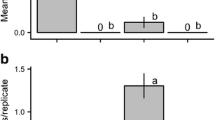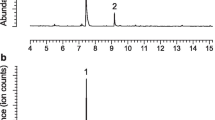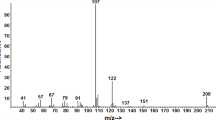Abstract
During field screening trials in Brazil, adults of both sexes of the cerambycid beetle Achryson surinamum (L.) (Cerambycinae: Achrysonini) were significantly attracted to racemic anti-2,3-octanediol, previously identified as a sex and aggregation-sex pheromone of various cerambycid species across different continents. Analyses of beetle-produced volatiles revealed that males of A. surinamum sex-specifically produce (2S,3R)-2,3-octanediol, as well as lesser amounts of (S)-2-methylbutan-1-ol. In field trials, both sexes of beetles were attracted by reconstructions of the species’ pheromone blend with synthesized components, confirming males produce an aggregation-sex pheromone. During the trials, the cerambycine Sphaerion inerme White (Elaphidiini) was attracted to some of the test lures, providing leads to its attractant pheromone. Subsequent analysis of extracts of headspace volatiles from live adults of S. inerme revealed that males produce a blend of (R)-2-methylbutan-1-ol and (R)-2-methylpentan-1-ol. In field tests, blends of racemic 2-methylbutan-1-ol+2-methylpentan-1-ol attracted significant numbers of beetles of both sexes. This study provides further examples of how identification of attractant pheromones of cerambycid species can be expedited by leveraging prior knowledge of the pheromone chemistry of related species.





Similar content being viewed by others
Data availability
Not applicable.
Code availability
Not applicable.
References
Bello JE, McElfresh JS, Millar JG (2015) Isolation and determination of absolute configurations of insect-produced methyl-branched hydrocarbons. Proc Nat Acad Sci USA 112:1077–1082
Bobadoye B, Torto B, Fombong A, Zou Y, Adlbauer K, Hanks LM, Millar JG (2019) Evidence of aggregation-sex pheromone use by longhorned beetles (Coleoptera: Cerambycidae) species native to Africa. Environ Entomol 48:189–192
Cossé AA, Zilkowski BW, Zou Y, Millar JG, Bauer L, Poland T (2020) Female-produced sex pheromone of Tetrastichus planipennisi, a parasitoid introduced for biological control of the invasive emerald ash borer, Agrilus planipennis. J Chem Ecol 46:508–519
Curkovic T, Arraztio D, Huerta A, Rebolledo R, Cheuquel A, Contreras A, Millar JG (2022) Generic pheromones identified from northern hemisphere Cerambycidae (Coleoptera) are attractive to native longhorn beetles from Central-Southern Chile. Insects 13:1067
Duffy EAJ (1953) A monograph of the immature stages of British and imported timber beetles (Cerambycidae). Order of the Trustees of the British Museum, London
Duffy EAJ (1960) A monograph of the immature stages of Neotropical timber beetles (Cerambycidae). Order of the Trustees of the British Museum, London
Fan J, Denux O, Courtin C, Bernard A, Javal M, Millar JG, Hanks LM, Roques A (2019) Multi-component blends for trapping native and exotic longhorn beetles at potential points-of-entry and in forests. J Pest Sci 92:281–297
Flaherty L, Gutowski JMG, Hughes C, Mayo P, Mokrzycki T, Pohl G, Silk P, Van Rooyen K, Sweeney J (2019) Pheromone-enhanced lure blends and multiple trap heights improve detection of bark and wood-boring beetles potentially moved in solid wood packaging. J Pest Sci 92:309–325
Girard DH (1968) List of intercepted plant pests, 1967: pests recorded from July 1, 1966, through June 30, 1967. USDA-ARS, Hyattsville
Hanks LM, Millar JG (2016) Sex and aggregation-sex pheromones of cerambycid beetles: basic science and practical applications. J Chem Ecol 42:631–654
Hayes RA, Griffiths MW, Nahrung HF, Arnold PA, Hanks LM, Millar JG (2016) Optimizing generic cerambycid pheromone lures for Australian biosecurity and biodiversity monitoring. J Econ Entomol 109:1741–1749
Lacey ES, Ginzel MD, Millar JG, Hanks LM (2004) Male-produced aggregation pheromone of the cerambycid beetle Neoclytus acuminatus acuminatus. J Chem Ecol 30:1493–1507
Maier CT (2017) Cerambycidae (Coleoptera) accidentally introduced into connecticut from China or from other areas in the United States. Proc Entomol Soc Wash 119:423
Meurisse N, Rassati D, Hurley BP, Brockerhoff EG, Haack RA (2019) Common pathways by which non-native forest insects move internationally and domestically. J Pest Sci 92:13–27
Millar JG, Hanks LM (2017) Chemical ecology of cerambycids. In: Wang Q (ed) Cerambycidae of the World: biology and pest management. CRC Press, Boca Raton, pp 167–202
Millar JG, Mitchell RF, Mongold-Diers JA, Zou Y, Bográn CE, Fierke MK, Ginzel MD, Johnson CW, Meeker JR, Poland TM, Ragenovich IR, Hanks LM (2018) Identifying possible pheromones of cerambycid beetles by field testing known pheromone components in four widely separated regions of the United States. J Econ Entomol 111:252–259
Millar JG, Richards AB, Halloran S, Zou Y, Boyd EA, Quigley KN, Hanks LM (2019) Pheromone identification by proxy: identification of aggregation-sex pheromones of North American cerambycid beetles as a strategy to identify pheromones of invasive Asian congeners. J Pest Sci 92:213–220
Monné MA (2024) Catalogue of the Cerambycidae (Coleoptera) of the neotropical region. Part I. subfamily Cerambycinae. https://cerambycids.com/catalog/. Accessed 4 Apr 2024
Quinn GP, Keough MJ (2002) Experimental design and data analysis for biologists. Cambridge University Press, Cambridge
Rassati D, Marini L, Marchioro M, Rapuzzi P, Magnani G, Poloni R, Di Giovanni F, Mayo P, Sweeney J (2019) Developing trapping protocols for wood-boring beetles associated with broadleaf trees. J Pest Sci 92:267–279
Ray AM, Lacey ES, Hanks LM (2006) Predicted taxonomic patterns in pheromone production by longhorned beetles. Naturwissenschaften 93:543–550
Roques A, Ren L, Rassati D, Shi J, Akulov E, Audsley N, Auger-Rozenberg M, Avtzis D, Battisti A, Bellanger R, Bernard A, Bernadinelli I, Branco M, Cavaletto G, Cocquempot C, Contarini M, Courtial B, Courtin C, Denux O, Dvořák M, Fan J, Feddern N, Francese J, Franzen EKL, Garcia A, Georgiev G, Georgieva M, Giarruzzo F, Gossner M, Gross L, Guarneri D, Hoch G, Hölling D, Jonsell M, Kirichenko N, Loomans A, Luo Y, McCullough D, Maddox C, Magnoux E, Marchioro M, Martinek P, Mas H, Mériguet B, Pan Y, Phélut R, Pineau P, Ray AM, Roques O, Ruiz M, Sarto i Monteys V, Speranza S, Sun J, Sweeney JD, Touroult J, Valladares L, Veillat L, Yuan Y, Zalucki MP, Zou Y, Žunič-Kosi A, Hanks LM, Millar JG (2023) Worldwide tests of generic attractants, a promising tool for early detection of non-native cerambycid species. NeoBiota 84:169–209
Sakai T, Nakagawa Y, Takahashi J, Iwabuchi K, Ishii K (1984) Isolation and identification of the male sex pheromone of the grape borer Xylotrechus pyrrhoderus Bates (Coleoptera: Cerambycidae). Chem Lett 13:263–264
Santos-Silva A, Botero JP, de Nascimento FEL, Silva WD (2020) A new synonym and seventeen new distributional records in South American Cerambycidae (Coleoptera), with notes on Chlorethe scabrosa Zajciw, 1963. Pap Avulsos Zool 60:e20206010
SAS Institute (2011) SAS/STAT v 93 User’s Guide. SAS Institute Inc, Cary
Silva WD, Zou Y, Bento JMS, Hanks LM, Millar JG (2017) Aggregation-sex pheromones and likely pheromones of 11 South American cerambycid beetles, and partitioning of pheromone channels. Front Ecol Evol 5:101
Silva WD, Millar JG, Hanks LM, Costa CM, Leite MOG, Tonelli M, Bento JMS (2018) Interspecific cross-attraction between the South American cerambycid beetles Cotyclytus curvatus and Megacyllene acuta is averted by minor pheromone components. J Chem Ecol 44:268–275
Silva WD, Hanks LM, Alvarez JCS, Madalon FZ, Bento JMS, Bello JE, Millar JG (2020) Variations on a theme: two structural motifs create species-specific pheromone channels for multiple species of South American cerambycid beetles. Insects 11:222
Silva WD, Hanks LM, Bento JMS, Millar JG (2021) 3-Hydroxyhexan-2-one and 3-methylthiopropan-1-ol as pheromone candidates for the South American cerambycid beetles Stizocera phtisica and Chydarteres dimidiatus dimidiatus, and six related species. J Chem Ecol 47:941–949
Silva WD, Hanks LM, Bento JMS, Zou Y, Millar JG (2024) Evidence for 3-hydroxyhexan-2-one as a shared pheromone component for 12 South American species of cerambycid beetles. J Econ Entomol. https://doi.org/10.1093/jee/toae075
Sokal RR, Rohlf FJ (1995) Biometry, 3rd edn. W. H. Freeman, New York
Sweeney JD, Silk PJ, Grebennikov V (2014) Efficacy of semiochemical-baited traps for detection of longhorn beetles (Coleoptera: Cerambycidae) in the Russian Far East. Eur J Entomol 111:397–406
Wickham JD, Millar JG, Hanks LM, Zou Y, Wong JCH, Harrison RD, Chen Y (2016) 2R,3S)-2,3-Octanediol, a female-produced sex pheromone of Megopis costipennis (Coleoptera: Cerambycidae: Prioninae. Environ Entomol 45:223–228
Acknowledgements
We thank Araci R. Silva, Cassio D. Silva (Valentim Gentil), Fernando Z. Madalon (USP/ESALQ, Piracicaba), and the staff at the Department of Forest Sciences of USP/ESALQ (Experimental Station of Forest Science at Itatinga) for their invaluable support during the field experiments. Special recognition goes to Antonio Santos-Silva of the Museum of Zoology of the University of São Paulo, MZUSP, whose expertise was pivotal in identifying the cerambycid species. Field collections of the study species in Brazil were conducted under SISBIO permit #46395 from the Brazilian Ministry of the Environment. Our work adheres to ethical guidelines, registered with the National System for the Management of Genetic Heritage and Associated Traditional Knowledge (SisGen, Brazil) under #AE3897B.
Funding
This work was supported by INCT-Semioquímicos na Agricultura (FAPESP grant # 2014/50871–0 and CNPQ grant # 465511/2014–7 to J.M.B.), Sao Paulo Research Foundation (grant # 2013/26936–2 to W.D.S.) and the United States Department of Agriculture—Animal and Plant Health Inspection Service (grant #s 15, 16, 17, 18, 19, 20, and 21–8130-1422-CA to J.G.M. and L.M.H., and grant #s 21, 22, and 23–8130-0909-CA to W.D.S.).
Author information
Authors and Affiliations
Contributions
All authors contributed to the study’s conception and design. W.D.S. collected insects, prepared extracts, performed initial chemical analyses, and conducted field bioassays. J.G.M. identified compounds, and Y.Z. synthesized several of the compounds used in this study. W.D.S. and L.M.H. carried out the statistical analyses. W.D.S. wrote the first draft of the manuscript, J.G.M. added sections related to chemistry, and J.G.M. and L.M.H. reviewed and edited the manuscript. Funding was acquired via grants submitted by L.M.H., J.M.B., and J.G.M. All authors read and approved the final manuscript.
Corresponding author
Ethics declarations
Conflict of interest
The authors declare no conflicts of interest.
Additional information
Communicated by Günther Raspotnig.
Rights and permissions
Springer Nature or its licensor (e.g. a society or other partner) holds exclusive rights to this article under a publishing agreement with the author(s) or other rightsholder(s); author self-archiving of the accepted manuscript version of this article is solely governed by the terms of such publishing agreement and applicable law.
About this article
Cite this article
Silva, W.D., Zou, Y., Hanks, L.M. et al. Pheromone chemistry of the Neotropical cerambycid beetles Achryson surinamum and Sphaerion inerme. Chemoecology (2024). https://doi.org/10.1007/s00049-024-00401-w
Received:
Accepted:
Published:
DOI: https://doi.org/10.1007/s00049-024-00401-w




